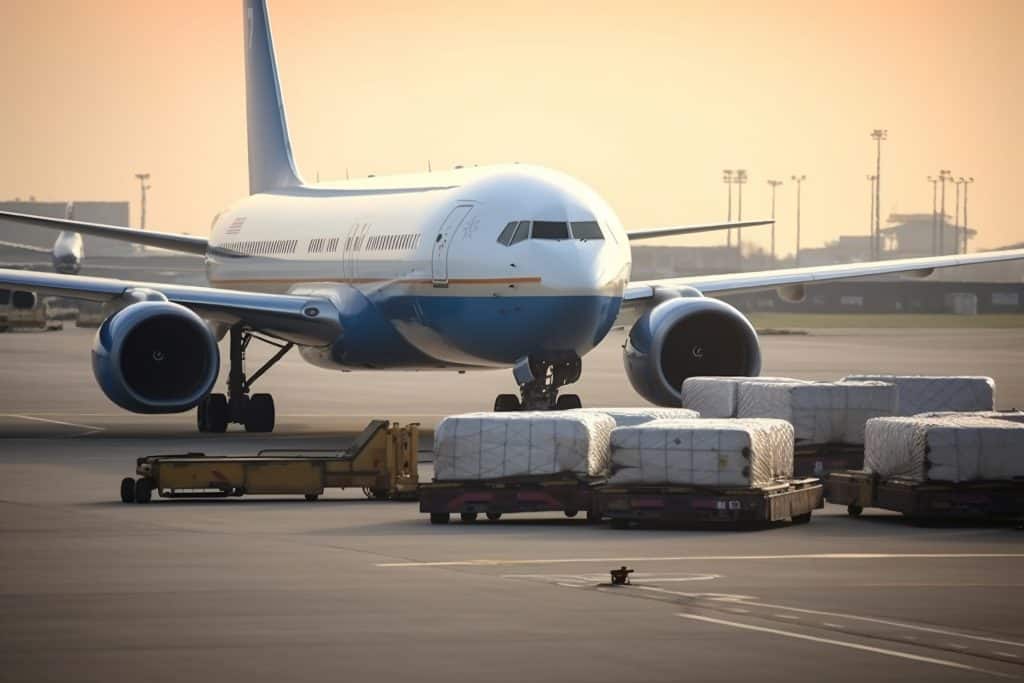Trade between China and the Middle East has seen significant growth over the past decade, driven by strong economic ties and the Middle East’s demand for high-quality and affordable Chinese products. From electronics and textiles to industrial machinery and consumer goods, businesses in the region increasingly rely on direct ordering and shipping from China to maintain their supply chains.
This comprehensive guide will cover the entire process of ordering and shipping from China to the Middle East, including shipping methods, estimated costs, transit times, customs procedures, and practical tips for seamless operations.

Table of Contents
Why Do Middle Eastern Countries Choose to Order Directly from China?
Middle Eastern countries opt to source goods directly from China due to its cost-effectiveness, product variety, and tailored solutions. China’s competitive manufacturing prices, driven by economies of scale and efficient production, make it an attractive choice for businesses seeking affordability without compromising quality.
China offers a diverse range of products, from electronics to textiles, often customized to suit Middle Eastern market preferences, such as halal certifications or culturally appropriate designs. The strong trade ties between China and the Middle East, supported by bilateral agreements and streamlined import procedures, further simplify the process.
Additionally, China’s advanced logistics infrastructure ensures reliable and flexible shipping options via sea, air, reducing transit times and costs. Platforms like Alibaba and multilingual communication support enhance accessibility, making it easier for businesses in the Middle East to negotiate and place orders directly.
How to Place Orders Directly from China
Sourcing products directly from China can be efficient and cost-effective if you follow these steps:
1. Identify Reliable Suppliers
- Online Platforms: Use trusted sites like Alibaba, Made-in-China, or Global Sources to find suppliers.
- Trade Fairs: Attend events like the Canton Fair to meet suppliers in person.
- Recommendations: Seek referrals from trusted business partners or networks.
2. Evaluate Supplier Credibility
- Check Certifications: Verify quality standards like ISO or CE certifications.
- Review Experience: Look for suppliers with a proven track record and positive reviews.
- Request Samples: Test product quality before committing to bulk orders.
3. Communicate and Negotiate
- Language Options: Many suppliers offer multilingual support, including English.
- Clarify Terms: Discuss pricing, payment methods, lead times, and shipping terms (e.g., FOB, CIF, DDP).
- Negotiate Costs: Secure competitive rates for bulk purchases or long-term partnerships.
4. Place Your Order
- Purchase Agreement: Ensure all terms are documented in a formal agreement.
- Confirm Details: Double-check product specifications, quantities, and delivery timelines.
5. Arrange Shipping and Logistics
- Choose a Freight Forwarder: They can handle shipping, customs clearance, and documentation.
- Select Shipping Mode: Decide between sea, air, or rail freight based on budget and urgency.
- Track Your Shipment: Use tracking tools to monitor delivery progress.
6. Manage Customs and Delivery
- Prepare Documentation: Ensure invoices, packing lists, and certificates of origin are complete.
- Handle Duties and Taxes: Work with a customs broker to clear goods efficiently.
- Final Delivery: Arrange transportation from the port or airport to your warehouse.
Tips for Success
- Build strong relationships with suppliers for smoother transactions.
- Start with small orders to test reliability and quality.
- Partner with an experienced logistics provider to simplify the process.
For hassle-free sourcing and shipping solutions, contact us today!
Shipping Methods from China to the Middle East
Transporting goods from China to the Middle East involves various shipping methods, each catering to different types of cargo, delivery timelines, and budgets. Here’s an overview of the most popular options:
Sea Freight China to the Middle East
Sea freight is the most cost-effective option for large or heavy shipments and is commonly used for bulk goods, machinery, and raw materials.
Features
- FCL (Full Container Load): Ideal for large shipments requiring a full container.
- LCL (Less than Container Load): Suitable for smaller shipments that share container space with other cargo.
Popular Ports
- China: Shanghai, Ningbo, Shenzhen, Guangzhou.
- Middle East: Jebel Ali (UAE), Dammam (Saudi Arabia), Jeddah (Saudi Arabia), Sohar (Oman).
Air Freight China to the Middle East
Air freight is the fastest option, making it ideal for time-sensitive or high-value goods like electronics, pharmaceuticals, and fashion items.
Features
- Express Shipping: Expedited delivery within 3–7 days.
- Standard Air Freight: Cost-effective for shipments that can allow slightly longer transit times.
Popular Airports
- China: Shanghai Pudong (PVG), Guangzhou Baiyun (CAN), Shenzhen Bao’an (SZX).
- Middle East: Dubai International (DXB), Riyadh King Khalid (RUH), Doha Hamad International (DOH).
Door-to-Door Shipping China to the Middle East
Door-to-door services provide a seamless solution, combining sea, air, or rail freight with last-mile delivery to the consignee’s address.
Features
- Covers all aspects of the shipping process, including customs clearance and delivery.
- Convenient for e-commerce and small businesses.
Transit Time
- Varies depending on the shipping method used for the main transit (sea, air).
DDP (Delivered Duty Paid) Shipping
DDP shipping ensures the seller handles all costs, including freight, customs duties, and taxes, delivering goods hassle-free to the buyer.
Features
- Comprehensive service covering shipping, clearance, and delivery.
- Suitable for businesses seeking a worry-free solution.
If you’re looking to ship from China to various countries in the Middle East, check out the following articles:
- Shipping From China to Saudi Arabia
- Shipping From China to UAE
- Shipping From China to Bahrain
- Shipping From China to Egypt
- Shipping From China to Qatar
- Shipping From China to Kuwait
- Shipping From China to Israel
- Shipping From China to Jordan
- Shipping From China to Iraq
- Shipping From China to Iran
- Shipping From China to Oman
- Shipping From China to Turkey
Major Ports for Shipping from China to the Middle East
Shipping from China to the Middle East involves several key ports on both ends. Here’s an overview of the primary departure and destination ports:
Major Departure Ports in China
These ports are among the busiest globally, offering extensive connectivity and efficient logistics services:
Shanghai Port
- Location: Eastern China.
- Highlights: The largest port in the world, handling high volumes of containerized cargo.
Ningbo-Zhoushan Port
- Location: Zhejiang Province, Eastern China.
- Highlights: Known for its efficiency in handling bulk and container cargo.
Shenzhen Port
- Location: Guangdong Province, Southern China.
- Highlights: Major gateway for electronics and manufacturing exports.
Guangzhou Port
- Location: Guangdong Province, Southern China.
- Highlights: Offers extensive trade routes to the Middle East and Africa.
Qingdao Port
- Location: Shandong Province, Northern China.
- Highlights: Key hub for goods from Northern China.
Major Destination Ports in the Middle East
These ports serve as critical hubs for imports and regional distribution:
Jebel Ali Port (UAE)
- Location: Dubai.
- Highlights: Largest port in the Middle East, a key hub for transshipment.
Port of Jeddah (Saudi Arabia)
- Location: Red Sea coast.
- Highlights: Primary gateway for imports into Saudi Arabia.
King Abdulaziz Port (Dammam, Saudi Arabia)
- Location: Persian Gulf.
- Highlights: Serves the Eastern Province of Saudi Arabia.
Port of Sohar (Oman)
- Location: Northern Oman.
- Highlights: Emerging hub for trade and industrial activity.
Port of Khalifa (UAE)
- Location: Abu Dhabi.
- Highlights: Known for advanced technology and automation.
Hamad Port (Qatar)
- Location: South of Doha.
- Highlights: Key gateway for goods entering Qatar.

Major Airports for Shipping from China to the Middle East
Air freight is a popular choice for time-sensitive and high-value shipments between China and the Middle East. Below are the key airports involved in this trade:
Major Airports in China
These airports are among the busiest and most well-equipped for international air freight:
Shanghai Pudong International Airport (PVG)
- Location: Shanghai, Eastern China.
- Highlights: Major hub for international cargo, handling electronics and high-value goods.
Guangzhou Baiyun International Airport (CAN)
- Location: Guangdong Province, Southern China.
- Highlights: A key gateway for exports from Southern China, especially electronics and textiles.
Shenzhen Bao’an International Airport (SZX)
- Location: Guangdong Province, Southern China.
- Highlights: Handles a significant volume of e-commerce and tech-related goods.
Beijing Capital International Airport (PEK)
- Location: Beijing, Northern China.
- Highlights: Primarily used for high-value goods and government-related cargo.
Chengdu Shuangliu International Airport (CTU)
- Location: Sichuan Province, Western China.
- Highlights: Increasingly important for air cargo due to growing trade from inland China.
Major Airports in the Middle East
The Middle East is home to several strategic airports that serve as cargo hubs:
Dubai International Airport (DXB)
- Location: Dubai, UAE.
- Highlights: A global logistics hub, handling a vast range of goods with rapid processing.
Hamad International Airport (DOH)
- Location: Doha, Qatar.
- Highlights: Known for its efficiency and advanced facilities for handling cargo.
Riyadh King Khalid International Airport (RUH)
- Location: Riyadh, Saudi Arabia.
- Highlights: Central hub for goods distributed across Saudi Arabia.
Jeddah King Abdulaziz International Airport (JED)
- Location: Jeddah, Saudi Arabia.
- Highlights: Handles imports destined for the western region of Saudi Arabia.
Muscat International Airport (MCT)
- Location: Muscat, Oman.
- Highlights: Important for cargo flowing into Oman and nearby regions.
Abu Dhabi International Airport (AUH)
- Location: Abu Dhabi, UAE.
- Highlights: Supports a variety of goods, with direct routes to major Chinese cities.
Estimated Shipping Costs from China to the Middle East
Shipping costs from China to the Middle East vary based on the mode of transport, cargo size, and destination. Below is an estimate for popular shipping methods:
Sea Freight (FCL & LCL)
| Origin Port (China) | Destination Port (Middle East) | 20FT Container (USD) | 40FT Container (USD) | LCL (USD/CBM) |
|---|---|---|---|---|
| Shanghai | Jebel Ali (UAE) | $1,500 – $1,800 | $2,600 – $3,000 | $50 – $80 |
| Ningbo | Dammam (Saudi Arabia) | $1,600 – $1,900 | $2,800 – $3,200 | $55 – $85 |
| Shenzhen | Jeddah (Saudi Arabia) | $1,700 – $2,000 | $2,900 – $3,300 | $60 – $90 |
| Guangzhou | Sohar (Oman) | $1,600 – $1,900 | $2,700 – $3,100 | $55 – $85 |
Air Freight
| Origin Airport (China) | Destination Airport (Middle East) | Standard Air Freight (USD/kg) | Express Air Freight (USD/kg) |
|---|---|---|---|
| Shanghai Pudong (PVG) | Dubai International (DXB) | $3.50 – $5.00 | $5.50 – $7.00 |
| Guangzhou Baiyun (CAN) | Riyadh King Khalid (RUH) | $4.00 – $5.50 | $6.00 – $7.50 |
| Shenzhen Bao’an (SZX) | Doha Hamad International (DOH) | $3.80 – $5.20 | $5.80 – $7.20 |
| Ningbo Lishe (NGB) | Muscat International (MCT) | $4.20 – $5.70 | $6.20 – $7. |
Door-to-Door (DDP)
| Shipping Method | Destination (Middle East) | Cost (USD/kg) | Estimated Total Cost (USD) |
|---|---|---|---|
| Sea Freight | UAE (Jebel Ali) | $1.00 – $2.50 | $200 – $500 for 200kg shipment |
| Air Freight | Saudi Arabia (Riyadh) | $4.50 – $6.50 | $900 – $1,300 for 200kg |
If you’re curious about the shipping costs from China to other countries in the Middle East, feel free to click and explore:
Shipping Costs for 20ft & 40ft Containers from China to Turkey
Transit Times for Shipping from China to the Middle East
The time it takes to ship goods from China to the Middle East depends on the shipping method, route, and final destination. Here’s an overview:
Sea Freight
| Origin Port (China) | Destination Port (Middle East) | Transit Time |
|---|---|---|
| Shanghai | Jebel Ali (UAE) | 20–25 days |
| Ningbo | Dammam (Saudi Arabia) | 22–27 days |
| Shenzhen | Jeddah (Saudi Arabia) | 23–28 days |
| Guangzhou | Sohar (Oman) | 25–30 days |
Air Freight
| Origin Airport (China) | Destination Airport (Middle East) | Transit Time |
|---|---|---|
| Shanghai Pudong (PVG) | Dubai International (DXB) | 3–5 days |
| Guangzhou Baiyun (CAN) | Riyadh King Khalid (RUH) | 4–6 days |
| Shenzhen Bao’an (SZX) | Doha Hamad International (DOH) | 3–6 days |
| Ningbo Lishe (NGB) | Muscat International (MCT) | 4–7 days |
Door-to-Door (DDP)
| Shipping Method | Estimated Transit Time |
|---|---|
| Sea Freight | 30–40 days |
| Air Freight | 7–10 days |
| Rail Freight | 35–45 days |

Tariffs and Customs Clearance from China to the Middle East
Importing goods from China to the Middle East requires navigating a range of tariffs, duties, and customs regulations. Here’s a comprehensive guide to help you streamline the process:
Key Components of Tariffs and Duties
Customs Duties
- Calculated based on the CIF value (Cost, Insurance, and Freight) of the goods.
- Duty rates vary by product type and destination country:
- Electronics: Typically around 5–10%.
- Textiles and Apparel: May range from 5–15%.
- Luxury Goods: Higher rates, depending on the country.
Value-Added Tax (VAT)
- Standard VAT Rates in the Middle East:
- UAE: 5%
- Saudi Arabia: 15%
- Oman, Qatar: 5%
- Applied on the total landed cost (CIF value + duties).
Excise Taxes
- Applied to specific goods like tobacco, beverages, or energy drinks. Rates vary across countries.
Required Documentation for Customs Clearance
To ensure a smooth customs clearance process, prepare the following documents:
- Commercial Invoice: Specifies the value and details of the goods.
- Packing List: Includes weight, dimensions, and contents of the shipment.
- Certificate of Origin: Verifies the goods’ country of manufacture.
- Bill of Lading (BOL) or Airway Bill: Serves as proof of shipment.
- Import License: Required for regulated products like medical equipment or food.
- Compliance Certificates: Necessary for specific goods (e.g., SASO in Saudi Arabia).
Customs Clearance Steps
Step 1: Document Submission
Submit all required documents to the customs authority of the destination country.
Step 2: Customs Inspection
Goods may be physically inspected to verify compliance with regulations and declared values.
Step 3: Payment of Duties and Taxes
Customs duties, VAT, and any excise taxes must be paid before goods are released.
Step 4: Approval and Release
Once cleared, goods can be transported to their final destination.
Common Challenges and Solutions
- Incorrect Classification of Goods: Use the correct HS (Harmonized System) code to avoid penalties.
- Incomplete Documentation: Work with experienced freight forwarders to ensure all paperwork is accurate.
- Regulated Goods: Ensure compliance with specific regulations like halal certifications for food or SASO standards for Saudi Arabia.
Tips for Smooth Customs Clearance
- Pre-Clearance: Submit documents in advance to expedite the process.
- Partner with Experts: Use customs brokers and freight forwarders familiar with Middle Eastern regulations.
- Stay Updated: Regularly review tariff changes or regulatory updates in the destination country.
Tips for Optimizing Shipping Costs China in the Middle East
1. Choose the Right Shipping Method
- Use sea freight for large, non-urgent shipments.
- Opt for air freight for time-sensitive or high-value goods.
2. Consolidate Shipments
Combine multiple orders into one shipment to save on freight costs.
3. Negotiate with Freight Forwarders
Partner with reliable freight forwarders like Tonlexing to secure competitive rates.
4. Avoid Peak Seasons
Plan shipments during off-peak periods to avoid high surcharges.
How Tonlexing Simplifies Shipping from China to the Middle East
Tonlexing offers comprehensive logistics solutions to make your shipping process seamless:
Customized Services: Tailored shipping solutions for sea, air, and express freight.
Competitive Pricing: Affordable rates for all shipping methods.
End-to-End Support: From order placement to final delivery.
Real-Time Tracking: Monitor your shipments at every step.
Expert Customs Assistance: Ensure hassle-free clearance in Middle Eastern ports.
Direct ordering and shipping from China to the Middle East offers immense opportunities for businesses. By understanding the shipping methods, costs, transit times, and customs requirements, you can streamline your operations and reduce costs. With Tonlexing’s expertise, you can ensure a smooth and efficient shipping experience tailored to your needs.
Contact Tonlexing today for reliable, cost-effective logistics solutions for your China-Middle East trade.


